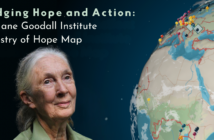An important chimpanzee conservation milestone occurred in 1990 when U.S. Fish and Wildlife Service (USFWS) declared under the Endangered Species Act that wild chimpanzees’ status would be classified as “endangered” rather than the previous “threatened.” Unfortunately for captive chimpanzees, they remained classified as only threatened. On June 12, 2015, USFWS announced a change in this policy — now all chimpanzees, wild and captive, will be classified as endangered. Dr. Jane Goodall comments on the new announcement in this interview and the video message below.
What is the change that just happened for chimpanzees in the Endangered Species Act?
Why is it important that all chimpanzees are listed as endangered?
How do you feel now that all chimpanzees are listed as endangered and offered the same protections under the Endangered Species Act?
What kind of impact do you expect this change will have for chimpanzees?
What is the impact of the international pet and entertainment trade on wild chimps?
Does the U.S. pet and entertainment trade undermine conservation of wild chimps?
What are the conservation impacts of using chimpanzees as biomedical research subjects?
What happens to chimpanzees who are hand-reared by humans or kept in social isolation?
Captive chimps have long been deprived of federal protection in the U.S. What impacts has this had on chimpanzees and on Americans’ understanding of the plight of the species?
What is the change that just happened for chimpanzees in the Endangered Species Act?
Now all chimpanzees, whether wild or captive, will be recognized as endangered under their listing on the Endangered Species Act.
Why is it important that all chimpanzees are listed as endangered?
Previously, captive chimpanzees were listed as threatened, which meant that they could be exploited for use in entertainment, as pets and in medical research most of which has been deemed not useful for human health. The new listing will make such exploitation more difficult.
How do you feel now that all chimpanzees are listed as endangered and offered the same protections under the Endangered Species Act?
I feel very relieved that all chimpanzees, whether they are captive or wild, will be listed as endangered which means that captive chimpanzees will be recognized as members of an endangered species. Many people have worked for more than two decades to bring about this change and it is a relief to know that we have finally succeeded. There is still much to be done before all chimpanzees can be assured of adequate protection, but this new listing is a huge step towards preventing much of the blatant exploitation that was possible before.
What kind of impact do you expect this change will have for chimpanzees?
This change shows that many people are finally beginning to understand that it is not appropriate to subject our closest relatives to disrespectful, stressful or harmful procedures, whether as pets, in advertising or other forms of entertainment, or medical research. That we are beginning to realize our responsibilities towards these sentient, sapient beings, and that the government is listening.
What is the impact of the international pet and entertainment trade on wild chimps?
Adult chimpanzees are killed for the illegal commercial bushmeat trade; but, since there is little meat on infants, they are seized from their dead mothers bodies and dragged into a harsh and bitter new life in the pet and entertainment trades. Poachers can make good money selling these live infants, and so the demand for pet and entertainment chimpanzees fuels further poaching. It is cruel, and it is driving chimpanzees to the brink of extinction in some parts of their range.
After the brutal separation of mother and child, the infant endures a nightmare journey to a local village or a dealer’s camp. The tied captive is crammed into a tiny box or pushed into a suffocating sack. A chimpanzee will suffer emotionally in almost exactly the same way a small human child would in the same circumstances. Many youngsters do not survive these journeys for they receive little if any attention and care along the way. Those that do make it are often wounded. All are dehydrated, starving and suffering from shock. More infants will die awaiting final transport. The survivors are sold to owners who either keep them as pets or use them to attract visitors to their hotels, or they are sold to the international live animal trade.
The business of capturing infant chimpanzees for the pet and entertainment trade is not only cruel but also horribly wasteful: at least 6-8 chimpanzees will die for every infant that survives to the end of the first year at its ultimate destination.
Does the U.S. pet and entertainment trade undermine conservation of wild chimps?
Not only is exploitation of chimpanzees as pets and in entertainment a horrible fate for captive chimpanzees – it also threatens wild populations and undermines conservation efforts. It is clear that the use of chimpanzees in entertainment is a significant driver for the demand for pet chimpanzees. This demand may be met, especially in the Middle East and parts of Asia, by buying infants whose mothers have been killed – either for bushmeat, or specifically to steal their infants. When chimpanzees are portrayed alongside Hollywood stars, people around the world are more inclined to want to acquire a pet chimpanzee themselves. Thus, the use of chimpanzees in U.S. media can indirectly contribute to increased poaching and trafficking of chimpanzees in Africa. Commercial exploitation of chimps contributes to the species’ decline, regardless of whether the exploited chimpanzee is born in captivity or in the wild.
A female chimpanzee does not have her first infant until she is about 12 or 13 years old, and she only has one infant every five years or so. Thus the loss of every individual chimpanzee, especially breeding females, has devastating long-term impacts on wild chimp populations that are already endangered. Some mothers escape, wounded, only to die later of their injuries, and their infants, deprived of essential maternal care, will typically die as well. Often youngsters are hit along with their mothers by the hunters, particularly when their weapons are old flintlocks stuffed with nails or bits of metal that cause injuries from shrapnel. If other chimpanzees in the vicinity respond to calls of distress, rushing to the defense of the mother and her child – as they often do – then they are also shot. It is likely that poachers kill and capture hundreds of chimpanzees every year – an utterly unsustainable rate for this slow-reproducing species.
What are the conservation impacts of using chimpanzees as biomedical research subjects?
Experimentation, when our closest living relatives are often treated as nothing more than inconveniently strong and potentially aggressive guinea pigs, certainly does not foster respect for the chimpanzee species and as such does not promote conservation.
The United States is the only country actively involved in invasive biomedical research on captive chimpanzees. Scientists use chimpanzees in an attempt to learn more about human diseases and develop treatments to save human lives, but a great many of such experiments have proven largely ineffective and have not led to advances in human medicine. Chimpanzees in laboratories live in a constant state of stress, under the relentless threat of physically invasive research protocols. Much of this research involves investigation of diseases of the immune system, such as HIV/AIDS, yet, the response of the immune system to a particular treatment may be skewed if the system is stressed.
Instead of keeping chimpanzees captive in stark research laboratories, science can benefit greatly from obtaining data in a non-invasive manner from wild chimpanzees living in protected areas and sanctuaries across Africa. Non-invasive research – such as the analysis of fecal samples – done in wild populations, closely monitored by scientists and conservationists, can benefit not only human medicine but chimpanzee well-being as well. A long-term research presence in the wild helps chimpanzee conservation by providing protection from poachers and, ideally, benefitting the local human population (by providing jobs and helping to improve lives and livelihoods such as JGI’s community based conservation program).
What happens to chimpanzees who are hand-reared by humans or kept in social isolation?
Chimpanzees that are kept as pets, whether born in the wild or in captivity, typically develop psychological abnormalities because their lives are vastly different from those of chimpanzees reared by their mothers in healthy social groups. Pet chimps are suspended between the chimpanzee and human worlds.
At first these youngsters are relatively easy to look after in the home – they are docile, affectionate and cute. As they grow older, however, they become harder to manage and by the time they are four or five years of age they have often become a liability. Chimpanzees are strong, curious and highly intelligent. They want to explore their environment, and they become gradually less docile – increasingly they must be disciplined and they resent punishment. Juvenile and adolescent chimpanzees may throw violent tantrums and bite, often injuring humans. If they are kept, they must spend more and more time locked up. When they are older, they may attack so violently that the chimpanzee must be killed – as was the case in 2009 in Connecticut, when a 14-year-old male, Travis, severely mauled a friend of his owner.
Sometimes owners may try to send adolescent chimps to a zoo — but all their lives these pet chimpanzees have been taught to behave like humans, so they do not know how to behave like a chimpanzee and seldom integrate successfully into a normal chimpanzee social group. Sanctuaries have been established to cater for chimpanzees exploited as pets or in entertainment, but there are not enough to cope with the number of privately owned chimps that need a place to go, which has led to a welfare crisis among captive chimpanzees.
Captive chimps have long been deprived of federal protection in the U.S. What impacts has this had on chimpanzees and on Americans’ understanding of the plight of the species?
The lack of federal legislation adequately protecting chimpanzees has led to the exploitation of captive chimpanzees in U.S. media, as pets and as subjects for biomedical research which has seldom led to any treatments that contributed to human health (which is why the NIH is retiring almost all its chimpanzes to sanctuaries). TV dramas, movies and advertising has a global audience today, and most viewers, watching the behavior of captive actors, do not realize the plight of wild chimpanzees. When the public does not have an understanding of the severity of the threat of extinction to a species, it is difficult to garner the required public support for conservation measures.
What can everyone do to help chimpanzees?
Contact your legislators to help continue increasing protections for chimpanzees both in the wild and in captivity.
Contribute to conservation organizations like the Jane Goodall Institute who are protecting chimpanzee populations and their habitat.
Learn about innovative ways that the Jane Goodall Institute is addressing conservation with high-tech tools and science.
Get involved with saving endangered species in your own community with Jane Goodall’s Roots & Shoots.
Learn about important issues in the world pertaining to chimpanzees and help join the community of people helping them. Check out Dr. Goodall’s latest statement on the situation with the chimpanzees abandoned by New York Blood Center in Liberia.





